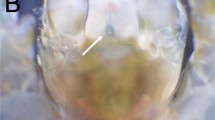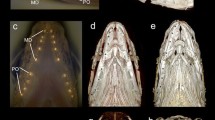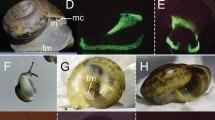Synopsis
The midshipman fish, Porichthys notatus, is a visually active nocturnal predator. It must acquire exogenous sources of luciferin to remain luminescent and feeds on a variety of luminescent prey. Its ecomorphological adaptations for nocturnal predation were examined by observing predation on zooplankton illuminated by dinoflagellates. Its visual sensitivity is well adapted for detection of its own luminescence and its prey's luminescence. P. notatus can detect the luminescence of dinoflagellates and use this indirect light to increase predation on nonluminescent prey. Flash frequency and duration modulated predation rates. The interval between flash onset and strike initiation regulated strike success. High prey concentration decreased predation success due to increased optical and mechanosensory noise. Other ecomorphological adaptations of this predator to its special photic environment include a pigmented digestive tract, duplex retina with the capacity to discriminate emission spectra, contractible pupil, and the potential to counter illuminate. These morphological adaptations combined with an ambush predator style allow effective predation while minimizing exposure risk.
Similar content being viewed by others
References cited
Allen, M.J. 1982. Functional structure of soft-bottom communities of the southern California shelf, Ph.D. Thesis, University of California, San Diego, La Jolla. 145 pp.
Ali, M.A. & M. Anctil. 1976. Retinas of fishes: an atlas. Springer-Verlag, New York. 284 pp.
Anctil, M. 1977. Development of bioluminescence and photophores in the midshipman fish, Porichthys notatus. J. Morphol. 151: 363–396.
Barnes, A.T, J.F. Case & F.I. Tsuji. 1973. Induction of bioluminescence in a luciferin deficient form of the marine teleost Porichthys notatus, in response to exogenous luciferin. Comp. Biochem. Physiol. 46A: 709–723.
Buck, J.B. 1978. Functions and evolutions of bioluminescence. pp 419–460. In: P.J. Herring(ed.) Bioluminescence in Action, Academic Press, London.
Burkenroad, M.D. 1943. A possible function of bioluminescence. J. Mar. Res. 5: 161–164.
Buskey, E., L. Mills & E. Swift. 1983. The effects of dinoflagellate bioluminescence on the swimming behavior of a marine copepod. Limnol. Oceanogr. 28: 575–579.
Case, J.F., J. Warner, A.T. Barnes & M. Lowestine. 1977. Bioluminescence of lanternfish (Myctophidae) in response to changes in light intensity. Nature 265: 179–181.
Esaias, W.E. & H.C. Curl Jr. 1972. Effect of dinoflagellate bioluminescence on copepod ingestion rates. Limnol. Oceanogr. 17: 901–906.
Hernandez, H.R. & F.I. Tsuji. 1976. Photopigment and spectral sensitivity in the bioluminescent fish Porichthys notatus. Mar. Biol. 34: 101–107.
Herring, P.J. 1982. Aspects of bioluminescence of fishes. Ocean. Mar. Biol. Ann. Rev. 20: 415–470.
Herring, P.J. 1983. The spectral characteristics of luminous marine organisms. Proc. R. Soc. London B. 220: 183–217.
Herring, P.J. 1990. Bioluminescence communication in the sea. pp. 245–264. In: P.J. Herring, A.K. Campbell, M. Whitfield & L. Maddock(ed.) Light and Life in the Sea Cambridge University Press, Cambridge.
Herring, P.J. & N.A. Locket. 1978. The luminescence and photophores of euphausiid crustaceans. J. Zool. Lond. 186: 431–462.
Herring, P.J. & J.G. Morin. 1978. Bioluminescence in fishes. pp. 273–329. In: P.J. Herring(ed.) Bioluminescence in Action, Academic Press, London.
Hobson, E.S., W.N. McFarland & J.R. Chess. 1981. Crepuscular and nocturnal activities of California fishes, with consideration of their scotopic visual pigments and the photic environment. U.S. Fish. Bull. 79: 1–30.
Ibara, R.M. 1967. Biology of the midshipman fish Porichthys notatus Girard. M.A. Thesis, University of California, Santa Barbara. 69 pp.
Jerlov, N.G. 1968. Optical oceanography. Elsevier, Amsterdam. 199 pp.
Lawry, J.W. 1974. Lanternfish compare downwelling light and bioluminescence. Nature 247: 155–157.
Levine, J.S. & E.F. MacNicol, Jr. 1979. Visual pigments in teleost fishes: effects of habitat, microhabitat, and behavior on visual system evolution. Sensory Processes 3: 95–131.
Locket, N.A. 1977. Adaptations to the deep-sea environment. pp. 67–192. In: F. Crescitelli (ed.) Handbook of Sensory Physiology. Vol. VII/6, Springer-Verlag, Berlin.
Locket, N.A. 1980. Variation of architecture with size in the multiple-bank retina of a deep sea teleost, Chauliodus sloani. Proc. R. Soc. Lond. B. 208: 223–242.
Locket, N.A. 1985. The multiple bank rod fovea of Bajacalifornia drakei, an alepocephalid deep sea teleost. Proc. Roy. Soc. Lond. B. 224: 7–22.
Lythgoe, J.N. 1972. The adaptation of visual pigments to the photic environment. pp. 566–603. In: H.J.A. Dartnall (ed.) Handbook of Sensory Physiology, Vol. 7, Springer-Verlag, Berlin.
Lythgoe, J.N. 1979. The ecology of vision. Clarendon Press, Oxford. 244 pp.
Lythgoe, J.N. 1980. Vision in fishes: ecological adaptations. pp. 431–445. In: M.A. Ali(ed.) Environmental Physiology of Fishes, Plenum-Press, New York.
Lythgoe, J.N. 1984. Visual pigments and environmental light. Vision Res. 24: 1–26.
Marshall, N.B. 1971. Explorations on the life of fishes. Harvard University Press, Cambridge, 204 pp.
McAllister, D.E. 1961. A collection of oceanic fishes from off British Columbia with a discussion of the evolution of black peritoneum. Bull. Nat. Mus. Can. 172: 39–43.
Mensinger, A.F. 1991. Bioluminescence and vision in the midshipman fish, Porichthys notatus. Ph.D. Thesis, University of California, Santa Barbara, 168 pp.
Mensinger, A.F. & J.F. Case. 1991. Bioluminescence maintenance in juvenile Porichthys notatus. Biol. Bull. 181: 181–188.
Mensinger, A.F. & J.F. Case. 1992. Dinoflagellate luminescence increases susceptibility of zooplankton to teleost predation. Mar. Biol. 112: 207–210.
Morin, J.G. 1983. Coastal bioluminescence: patterns and functions. Bull. Mar. Sci. 33: 787–817.
Morin, J.G., A. Harrington, K. Nealson, N. Krieger, T.O. Baldwin & J.W. Hastings. 1975. Light for all reasons: versatility in the behavioral repertoire of the flashlight fish. Science 190: 74–76.
Nicol, J.A.C. 1978. Bioluminescence and vision. pp 367–398. In: P.J. Herring(ed.) Bioluminescence in Action, Academic Press, London.
Partridge, J.C. 1989. Visual pigments of deep-sea fishes: ecophysiology and molecular biology Prog. Underwater Sci. 14: 17–31.
Shand, J., J.C. Partridge, S.N. Archer, G.W. Potts & J.N. Lythgoe. 1988. Spectral absorbance changes in the violet/blue sensitive cones of the juvenile pollack, Pollachius pollachius. J. Comp. Physiol. A 163: 699–703.
Somiya, H. 1980. Fishes with eye shine: functional morphology of guanine type tapetum lucidum. Mar. Ecol. Prog. Ser. 2: 9–26.
Warner, J.A. & J.F. Case. 1980. The zoogeography and dietary induction of bioluminescence in the midshipman fish, Porichthys notatus. Biol. Bull. 159: 231–246.
White, H.H. 1979. Effects of dinoflagellate bioluminescence on the ingestion rates of herbivorous zooplankton. J. Exp. Mar. Biol. Ecol. 36: 217–224.
Widder, E.A. & J.F. Case. 1982. Luminescent microsource activity in bioluminescence of the dinoflagellate, Pyrocystis fusiformis. J. Comp. Physiol. 145: 517–527.
Widder, E.A., M. Latz & J.F. Case. 1983. Marine bioluminescence spectra measured with an optical multichannel detection system. Biol. Bull. 165: 791–810.
Widder, E.A. 1992. Mixed light imaging system for recording bioluminescence behaviours. J. Mar. Biol. Ass. U.K. 72: 131–138.
Author information
Authors and Affiliations
Rights and permissions
About this article
Cite this article
Mensinger, A.F. Ecomorphological adaptations to bioluminescence in Porichthys notatus . Environ Biol Fish 44, 133–142 (1995). https://doi.org/10.1007/BF00005911
Received:
Accepted:
Issue Date:
DOI: https://doi.org/10.1007/BF00005911




